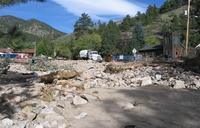-
U.S. military must be ready for climate change: Hagel
Climate change is a threat multiplier, and the U.S. Defense Department is taking steps to incorporate this issue into all planning, Defense Secretary Chuck Hagel said in Peru Monday. Climate change has the potential to exacerbate many of the challenges the world already confronts, from the spread of infectious diseases to spurring armed conflicts, Hagel said at the Conference of the Defense Ministers of the Americas. Hagel announced a Defense Department Climate Change Adaptation Roadmap during his speech. The roadmap is based on science, he said, and describes the effects of climate change on DoD’s missions and responsibilities.
-
-
15 years from now, our impact on regional sea level will be clear

Coastal communities and industries require information on regional sea-level change to develop strategies for reducing the risk to population, infrastructure and the environment. This requires modeling projections of sea-level rise, estimating the costs and benefits of adaptation options, and understanding the impacts on coastal ecosystems. Inundation maps that can be used to identify areas that are most vulnerable to rising sea levels are particularly valuable. Adaptation measures may include land-use planning such as preventing building in low lying areas, increasing or maintaining a vegetated coastal margin that serves as a buffer zone against extreme sea levels, or using protective sea walls in the long run if certain sea level rise thresholds are exceeded.
-
-
Simulations reveal California’s resilience to extreme droughts
The results from a series of several-year-old computer simulations reveal that the state of California may be more resilient to long-term drought conditions than previously believed. “The results were surprising,” said one of the scientists involved in the study. “California has a remarkable ability to weather extreme and prolonged droughts from an economic perspective.”
-
-
Some states are better prepared than others for climate change challenges
In recent years, a number of states have started taking action to prepare their communities for climate change. Many have even developed specific adaptation plans to guide their work. Until now, though, no one has been able to define how much progress states are actually making in implementing those plans. The Georgetown Climate Center’s (GCC) online tool, the State Adaptation Progress Tracker, changes that. A GCC release says that now, anyone will be able to quickly determine how much progress their state is making and decision-makers will be able to learn from innovative examples of actions other states are taking.
-
-
The likelihood of a California Big One “uncomfortably high”: Experts

Research on the San Andreas fault has shown that the average time between surface-rupturing earthquakes is about a century. Experts say that these findings are a call to action. The last two “big ones” on the San Andreas fault — in 1906 in Northern California and 1857 in Southern California — occurred more than a century ago. There are several ways to calculate the probability of a similar earthquake, but they all give uncomfortably high results. A large earthquake is likely in our lifetime. A magnitude 7.8 earthquake is realistic, one expert says. “Our data show that similar earthquakes happened here in the not-too-distant past. As Shakespeare said, past is prologue. However, past large earthquakes on the San Andreas fault affected very few people. Now millions are at risk.”
-
-
Open data sources can help localities prepare for disasters
States and local governments must improve their use of open-data sources to prepare for disasters, according to a trio of emergency management experts from academia, government, and the private sector. Experts agreed that public data reveals an increasing need for infrastructure upgrades in U.S. cities, but local governments tend to adopt short-term measures over long-term protections.
-
-
As sea level rises, coastal communities brace for more frequent, destructive tidal flooding
Today, many coastal communities are seeing more frequent flooding during high tides. As sea level rises higher over the next fifteen to thirty years, tidal flooding is expected to occur more often, cause more disruption, and even render some areas unusable — all within the time frame of a typical home mortgage. An analysis of fifty-two tide gauges in communities stretching from Portland, Maine to Freeport, Texas shows that most of these communities will experience a steep increase in the number and severity of tidal flooding events over the coming decades, with significant implications for property, infrastructure, and daily life in affected areas. The report warns that given the substantial and nearly ubiquitous rise in the frequency of floods at these fifty-two locations, many other communities along the East and Gulf Coasts will need to brace for similar changes.
-
-
California needs $54 million to deploy ShakeAlert earthquake warning system
Officials in California need $54 million fully to implement the ShakeAlert earthquake warning system, according to a scientist with the U.S. Geological Survey (USGS).ShakeAlert detects earthquakes using the California Integrated Seismic Network of roughly 400 ground motion sensors which identify primary waves (P-waves) as they move through the Earth at almost twice the speed of the earthquakes’ destructive S-waves, which shake the ground.When an earthquake is detected, ShakeAlert informs emergency management officials of the quake’s epicenter, and a computer-generated voice counts the remaining time before shaking occurs.
-
-
Scientist reveals Chelyabinsk meteorite fall’s seismo-ionospheric effects
The meteorite which hit the Russian city of Chelyabinsk on 15 February 2013 was the cause of a large number of dynamic ionospheric, atmospheric, and seismic phenomena. Its explosion created panic among local residents and about 1,500 people were injured seriously enough to seek medical treatment. All of the injuries were due to indirect effects rather than the meteor itself, mainly from broken glass from windows that were blown in when the shock wave arrived, minutes after the superbolide’s flash.
-
-
Boston developers continue to build on the waterfront, but take account of sea level rise
The threat of rising sea levels has not discouraged property developers and buyers in Boston from investing in multi-million dollar condos located along the city’s waterfront. Boston developers are keeping copies of key building records off-site in case electricity shuts down during a storm surge. Some developers are moving mechanical systems from the basements of high rises to several stories above ground, to ensure power and critical systems are intact during a flood.
-
-
2013 Colorado Front Range flood: Debris-flow a major hazard

Between 9 and 13 September 2013, more than 1,100 debris flows occurred in an area of about 3,400 square kilometers in Colorado’s Front Range, most of which were triggered by two periods of intense rainfall. The massive flooding, and the concomitant landslides and debris flows, caused widespread damage across the Front Range.
-
-
The Big One will have frightening consequences for Los Angeles: Scientists
Scientists cannot accurately predict when California’s next massive earthquake – or, the Big One – will strike, but they can predict the effects, and it is frightening. Scientists with the U.S. Geological Survey (USGS) say these effects will include powerless rescue services, widespread fire damage, and no fresh water for months on end. The 1994 Northridge Earthquake was the region’s the last mega-quake, but scientists say that “When we have the San Andreas earthquake, that earth fault will probably be about 20 to 30 times larger than the fault that produced the Northridge earthquake [which still resulted in $20 Billion in damages].”
-
-
California communities running out of water
Since January, a number of California communities in the Central Valley have been experiencing such extreme drought that they have been placed on a “critical water systems” list — a ranking indicating that the areas could run completely dry within sixty days. Many of these areas have had wells dried up since July.
-
-
Better planetary vital signs should replace 2° C warming goal as targets for climate action
As climate instability increases across the planet, limiting global surface air temperature increase above pre-industrial levels to an average of 2° C (3.6° F) has become a popular metric for success in the public eye. Two researchers argue, however, that the goal is a misleading one. Though it is a relatively tangible concept to appreciate, the standard does not correlate well to prescribed government actions such as limiting fossil fuel use or establishing carbon markets. “Scientifically, there are better ways to measure the stress that humans are placing on the climate system than the growth of average global surface temperature — which has stalled since 1998 and is poorly coupled to entities that governments and companies can control directly,” the researchers say.
-
-
California agriculture faces greatest water loss ever seen
California produces nearly half of U.S.-grown fruits, nuts, and vegetables, and nearly a quarter of the nation’s milk and cream. Across the nation, consumers regularly buy several crops grown almost entirely in California, including tomatoes, carrots, broccoli, almonds, walnuts, grapes, olives, and figs. Researchers show that California agriculture is weathering its worst drought in decades due to groundwater reserves, but the nation’s produce basket may come up dry in the future if it continues to treat those reserves like an unlimited savings account.
-
More headlines
The long view
The Surprising Reasons Floods and Other Disasters Are Deadlier at Night
It’s not just that it’s dark and people are asleep. Urban sprawl, confirmation bias, and other factors can play a role.
Why Flash Flood Warnings Will Continue to Go Unheeded
Experts say local education and community support are key to conveying risk.
